There are a number of investigations you may need to have done when you are completing a building project. Perry Testing Ltd can provide the following tests, on site, with minimal disruption and immediate feedback in the form of reports and certificates that show your build meets all the required regulations.
The structural investigation methodologies carried out by Perry Testing Ltd are designed to ensure safety. They check that the construction is fit for the purpose it was built for. For example, we can slip test surfaces that are to be used as pavements to make sure that the likelihood of an accident is minimised. These can potentially lead to compensation claims and questions about the quality of workmanship, which can damage your reputation too.
We can also check for defects in building materials, such as concrete, using Ultrasonic testing equipment. The tests we have also look at the integrity of joints using our Pull Off and Pull Out tests, which are exactly what you’re thinking, tests that pull out and off to check the strength.
These tests are not only designed to check the final structure, but they can also be used throughout the construction process so that you can be sure that the ground or structure is ready for the next stage of the project. For example, we could load test surfaces, such as roads and pavements, before the final layers are put down. This is useful as finding that the underlying materials are not up to regulations would prove costly and time-consuming. This is not what you want when you have a project to finish with tight schedules and budgets to adhere to.
We can provide you with the certificates of compliance there and then, so you can have complete confidence in your construction with no costly waiting for reports to be produced. If issues are found, we can advise on what remedial work needs to be carried out to bring the project back on track.
The tests we have available are:
Screed Soundness Test – a simple test that involves dropping a weight onto the floor and measuring the soundness of the screed required for a cement and sand floor.
Relative Humidity Test – this is a good idea before putting down further layers. It tests that the surface is suitably dry enough for the next step of construction.
Load Testing – this test is carried out using a hydraulic ram or test weight and is used to determine what load a structure or surface can withstand. It can be used on balconies and balustrades, lifts and lifting beams and all kinds of surfaces, such as slabs and asphalt.
Ultrasonic Testing – Ultrasonic waves are used to ‘see’ through concrete structures and determine if they have any faults, such as cracks or voids.
Pull Off Tests /Pull Out Tests – The first of these tests is usually used to determine the strength of bond between sprayed concrete layers and render coatings. The second is similar but designed to test structural fixings, as well as rebar and threaded bar. We also have a specially designed kit that allows us to test in a variety of situations.
Schmidt Hammer Survey – this test is to find and address areas of concrete that have low compressive strength using a rebound system.
Concrete Diamond Drilling – our experienced engineers can drill into a wide variety of surfaces, take dust samples, and perform a number of different tests, depending on what is required. If this is something you need, give us a call to talk through the options.
Concrete Assessment Survey – we would use a number of the procedures described above to test concrete structures. In addition, we can also carry out the following tests should you need them.
- Cover Meter Surveys
- Carbonation Testing
- Cement Content Testing
- Chloride Testing
- Alkali-silica reaction (ASR)
- Sulphate Testing
- Presence of HAC
- Concrete Resistivity Testing
- Rebound Hammer Survey
- Tap Hammer Survey / Delamination Survey
If you think Perry Testing can help you complete your project with structural investigation, why not get in touch? Call us and speak to one of our experienced engineers today – we’re always happy to help.







